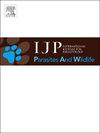Occurrence of tick-borne haemoparasites in South African rodent species evidence of Babesia microti-like sequence variants in two Rhabdomys species
IF 2.2
3区 医学
Q3 ECOLOGY
International Journal for Parasitology-Parasites and Wildlife
Pub Date : 2025-02-27
DOI:10.1016/j.ijppaw.2025.101051
引用次数: 0
Abstract
In recent years, vector-borne viral, bacterial and parasitic diseases have emerged or re-emerged in many geographic regions, causing health and economic problems. Wildlife can act as reservoirs for many human and livestock diseases and that arthropods are often involved in the transmission of these pathogens. Little is known about the zoonotic pathogens that naturally occur in wild rodent and insectivorous shrew species in South Africa. The aims of the study were to: 1) record the tick-borne haemoparasite diversity associated with rodents and shrews at several localities in South Africa, and 2) characterise Babesia microti that occur in rodents using Sanger sequencing of the parasite 18S ribosomal RNA (rRNA) gene and internal transcribed spacer region 1 (ITS1). Nine wild rodent genera (species: n = 412) and two insectivorous shrew genera (species: n = 11) were simultaneously screened for the presence of Theileria, Babesia, Ehrlichia and Anaplasma species using the Reverse Line Blot (RLB) hybridization assay. The RLB PCR amplicons obtained from Mastomys spp., Micaelamys namaquensis, Mus musculus, Rhabdomys dilectus and R. pumilio hybridized with the following RLB species-specific probes: Babesia microti (11.3%), Anaplasma bovis (3.5%), Anaplasma phagocytophilum (1.8%) and Ehrlichia ruminantium (3.5%). The near full-length 18S rRNA gene and partial ITS1 spacer region of 12 of the specimens were cloned and the recombinants sequenced. Babesia microti-like 18S rDNA and ITS1 sequence variants were recorded in two rodent species (Rhabdomys dilectus and Rhabdomys pumilio). The B. microti-like 18S rDNA sequence variants, obtained in this study, clustered phylogenetically within the established B. microti-like clade (Clade I). Nevertheless, they formed a distinct South African group that seems to differ significantly from B. microti sensu stricto and could potentially represent a fifth distinct lineage within the B. microti-like clade.The study highlights the potential of small mammals acting as important reservoirs for vector-borne haemoparasites in South Africa.

南非啮齿动物中蜱传血液寄生虫的发生:在两种横纹肌鼠中发现微小巴贝斯虫样序列变异的证据
近年来,病媒传播的病毒、细菌和寄生虫病在许多地理区域出现或重新出现,造成健康和经济问题。野生动物可作为许多人类和牲畜疾病的宿主,节肢动物经常参与这些病原体的传播。人们对南非野生啮齿动物和食虫鼩中自然存在的人畜共患病原体知之甚少。本研究的目的是:1)记录南非几个地区与啮齿动物和鼩鼱相关的蜱传血寄生虫的多样性;2)利用寄生虫18S核糖体RNA (rRNA)基因和内部转录间隔区1 (ITS1)的Sanger测序来表征啮齿动物中发生的微小巴贝虫。采用逆行杂交(RLB)技术,对9个野生啮齿动物属(n = 412)和2个食虫鼩属(n = 11)同时进行了伊氏杆菌、巴贝斯虫、埃利希体和无原体的杂交检测。从Mastomys spp.、Micaelamys namaquensis、musus musus、Rhabdomys dilectus和R. pumilio获得的RLB扩增子与以下RLB物种特异性探针杂交:微小巴贝虫(11.3%)、牛无形体(3.5%)、嗜吞噬细胞无形体(1.8%)和反刍埃利希体(3.5%)。克隆了其中12个样本的近全长18S rRNA基因和部分ITS1间隔区,并对重组基因进行了测序。在两种啮齿类动物(横纹肌鼠和矮横纹肌鼠)中记录了微小巴贝虫样18S rDNA和ITS1序列变异。在本研究中获得的小分枝杆菌样18S rDNA序列变异,在系统发育上聚集在已建立的小分枝杆菌样进化枝(进化枝I)中。然而,它们形成了一个独特的南非类群,似乎与严格意义上的小分枝杆菌有很大不同,可能代表了小分枝杆菌样进化枝中的第五个不同谱系。这项研究强调了小型哺乳动物在南非作为媒介传播的血液寄生虫的重要宿主的潜力。
本文章由计算机程序翻译,如有差异,请以英文原文为准。
求助全文
约1分钟内获得全文
求助全文
来源期刊

International Journal for Parasitology-Parasites and Wildlife
Medicine-Infectious Diseases
CiteScore
3.80
自引率
5.60%
发文量
113
审稿时长
45 days
期刊介绍:
The International Journal for Parasitology: Parasites and Wildlife (IJP-PAW) publishes the results of original research on parasites of all wildlife, invertebrate and vertebrate. This includes free-ranging, wild populations, as well as captive wildlife, semi-domesticated species (e.g. reindeer) and farmed populations of recently domesticated or wild-captured species (e.g. cultured fishes). Articles on all aspects of wildlife parasitology are welcomed including taxonomy, biodiversity and distribution, ecology and epidemiology, population biology and host-parasite relationships. The impact of parasites on the health and conservation of wildlife is seen as an important area covered by the journal especially the potential role of environmental factors, for example climate. Also important to the journal is ''one health'' and the nature of interactions between wildlife, people and domestic animals, including disease emergence and zoonoses.
 求助内容:
求助内容: 应助结果提醒方式:
应助结果提醒方式:


